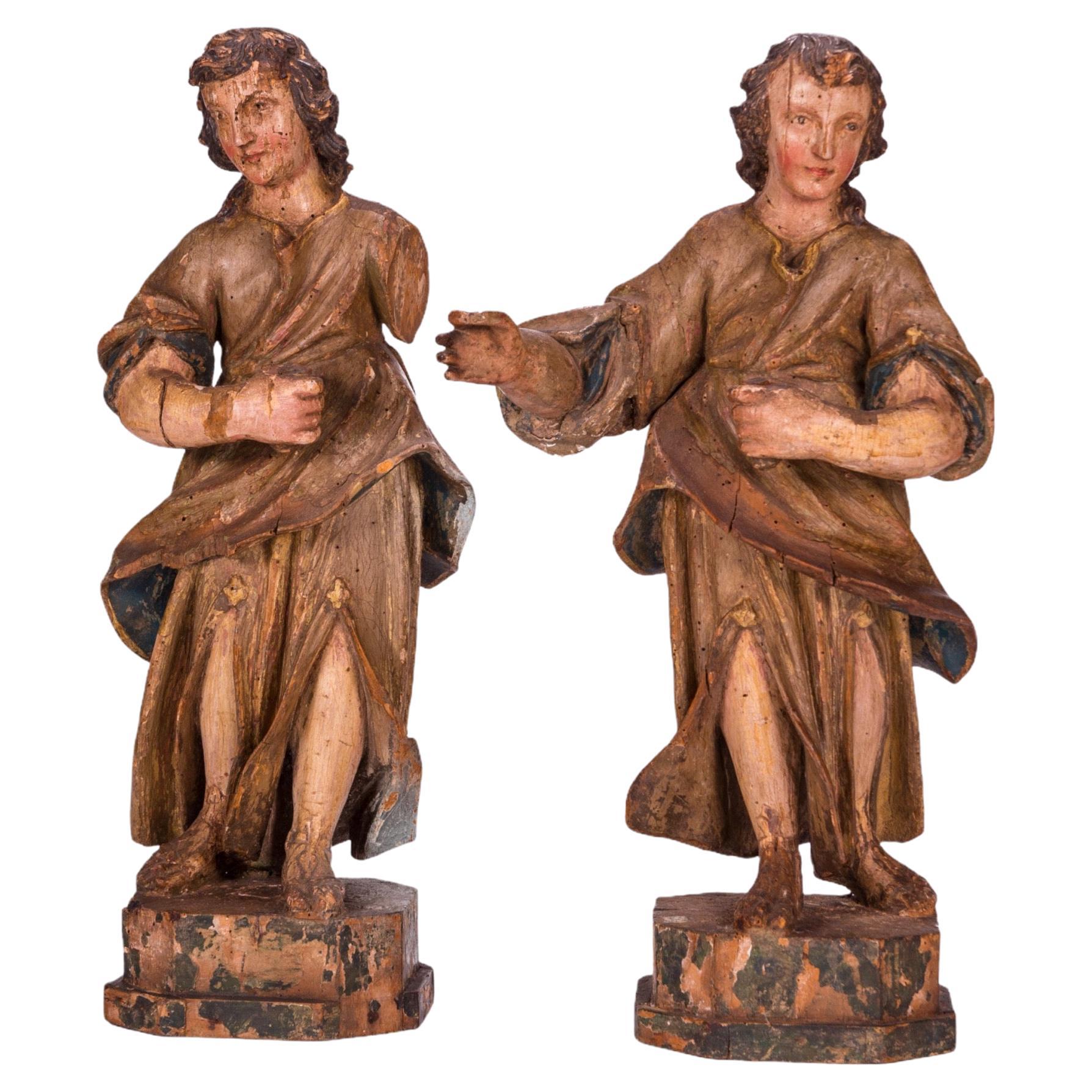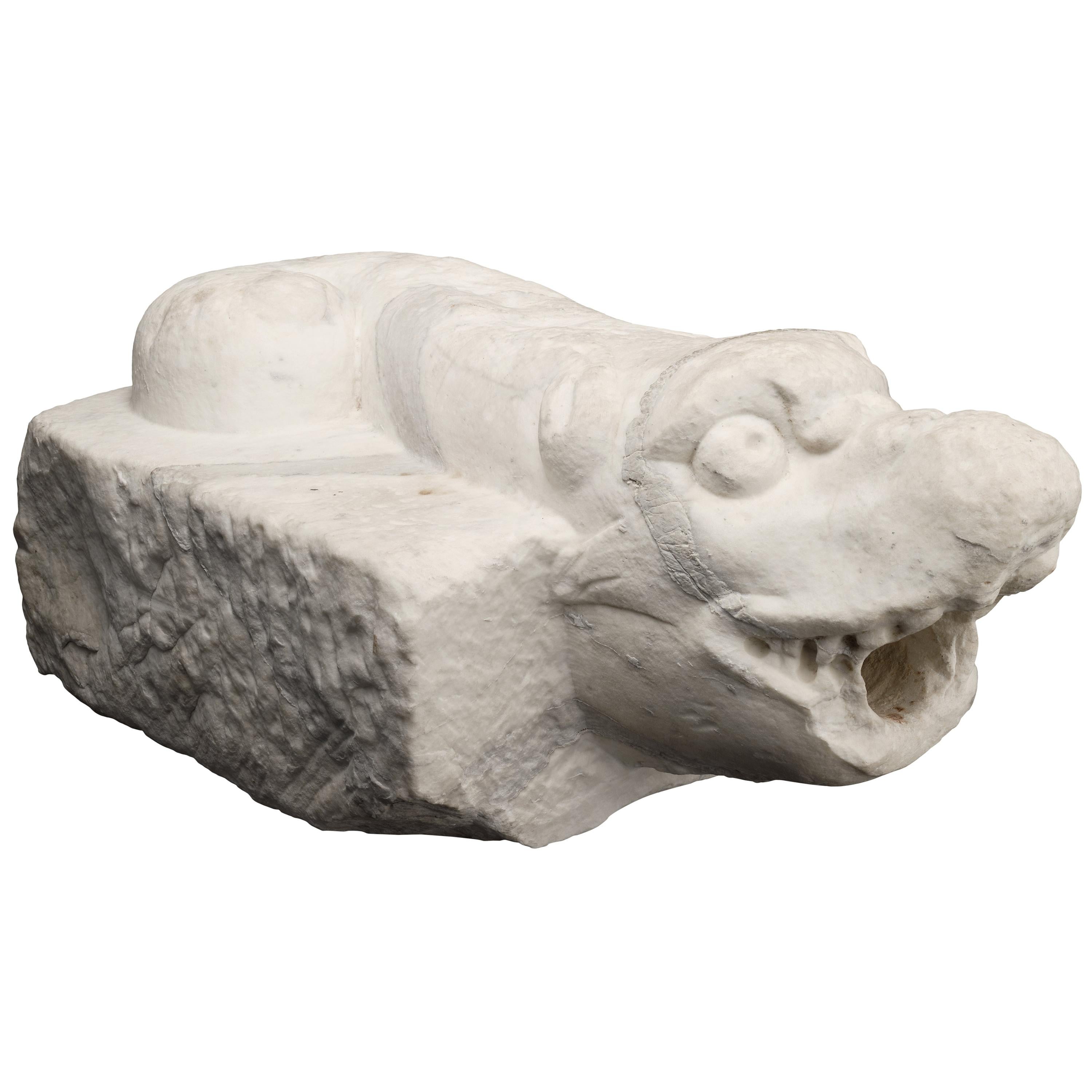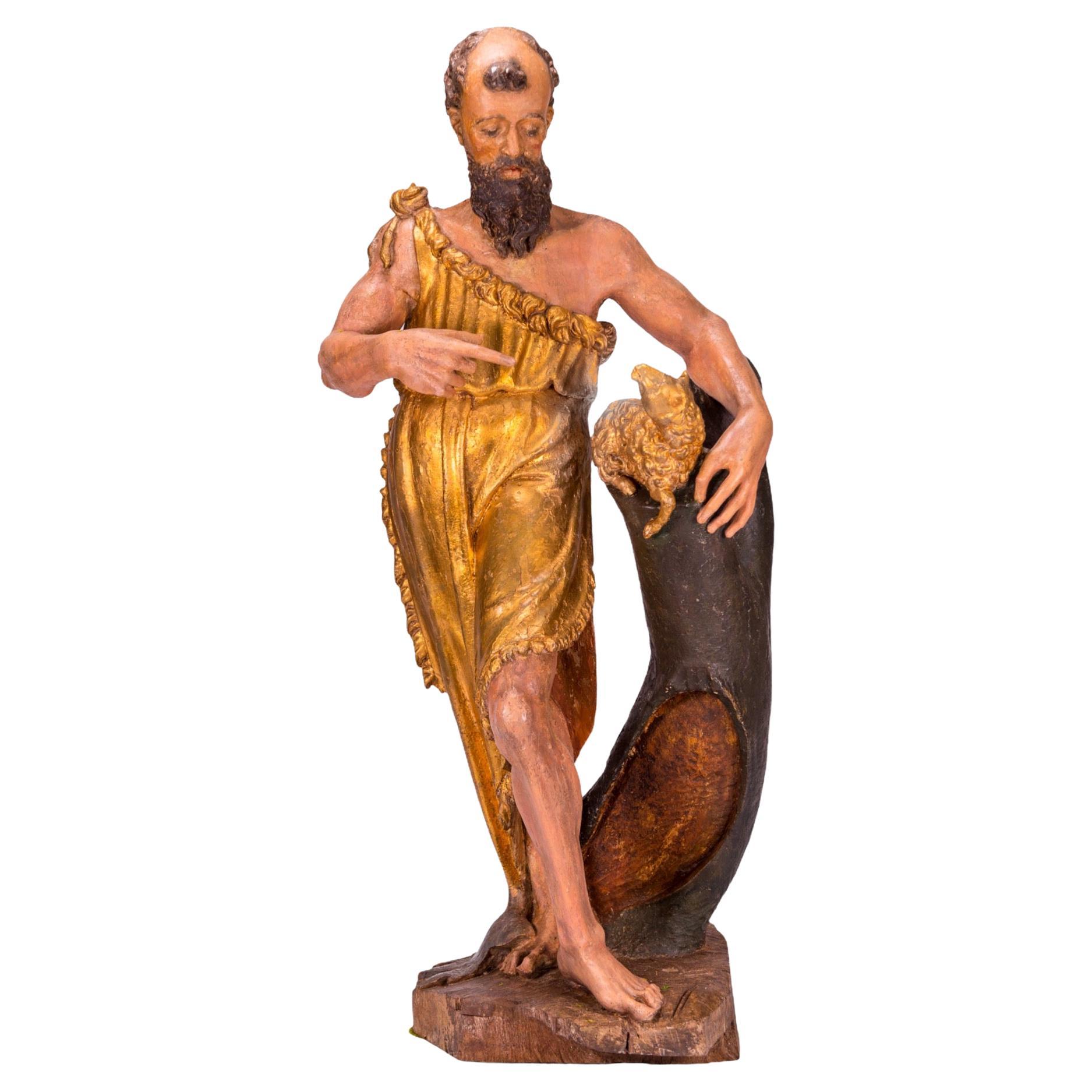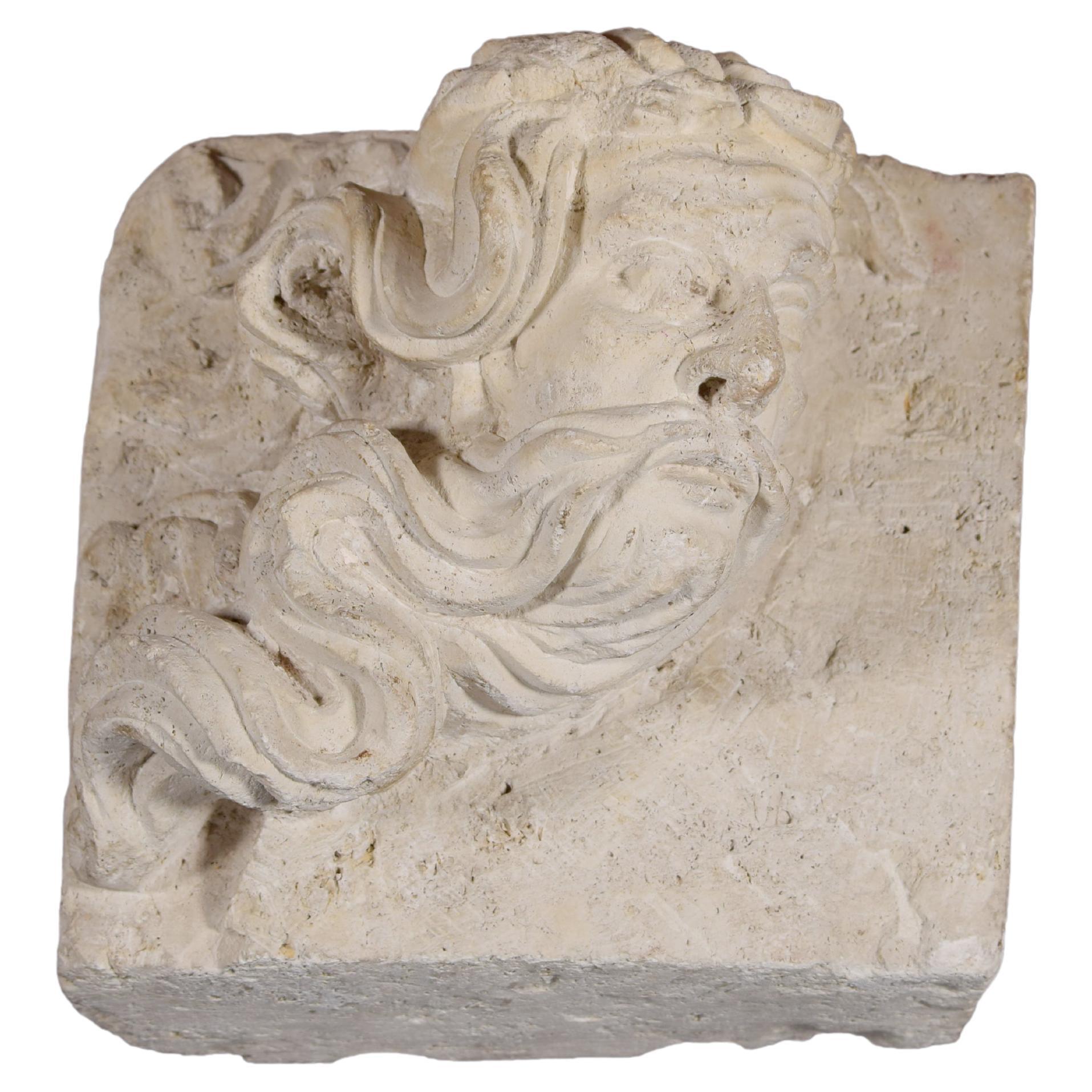Items Similar to A 16th century carved marble sculpture of poseidon
Want more images or videos?
Request additional images or videos from the seller
1 of 8
A 16th century carved marble sculpture of poseidon
About the Item
This fine and imposing sculpture is an excellent example of 16th century Italian craftsmanship. The figure is stood on a raised, shaped rectangular base with a carved "dolphin" at the figure's right heel. Part robed, the figure stands with the left arm held aloft holding a fish.
Whilst signed and dated "P. Torregiano 1521" purportedly for Pietro Torrigiano (24 November 1472 – July/August 1528), it is almost certainly a later piece and is likely to have been made within the circles of sculptors such as Michelangelo Naccherino (Florence, March 6, 1550 – Naples, February, 1622) in the late 16th century.
- Dimensions:Height: 61.82 in (157 cm)Width: 27.56 in (70 cm)Depth: 17.72 in (45 cm)
- Style:Renaissance (Of the Period)
- Materials and Techniques:
- Place of Origin:
- Period:
- Date of Manufacture:circa 1580
- Condition:Repaired: apparent but sympathetic repairs to the left arm and nose. Wear consistent with age and use. Minor fading.
- Seller Location:London, GB
- Reference Number:1stDibs: LU8883238078742
About the Seller
No Reviews Yet
Recognized Seller
These prestigious sellers are industry leaders and represent the highest echelon for item quality and design.
1stDibs seller since 2023
- ShippingRetrieving quote...Ships From: London, United Kingdom
- Return PolicyA return for this item may be initiated within 14 days of delivery.
More From This SellerView All
- A 19th C electrotype of a 16th C Italian Shield by Elkington & Co.By Elkington & Co.Located in London, GBA circular shield depicting classical battle scenes. Another similar example can be found in the Metropolitan Museum of Art Accession Number: 07.102.7. Biography: Elkington & Co, f...Category
Antique 19th Century British Renaissance Revival Sheffield and Silverplate
MaterialsSilver Plate
- Pair of Decorative Ewer Form OrnamentsLocated in London, GBThe body of each ewer is beautifully embellished with a three dimensional design of grapevines following up to the handle. The handle part forms as a satyr, possibly representative o...Category
Antique Late 19th Century French Neoclassical Figurative Sculptures
MaterialsSilver Plate
- A silver plated bronze sculptural group of a Cockerel By ChristofleLocated in London, GBThis silver plated bronze sculptural group of a Cockerel and a chicken an a gilt-bronze mounted hard-stone base was made in Circa 1890 by ChristofleCategory
Antique 19th Century Animal Sculptures
MaterialsSilver Plate
- Set of 4 Late 19th Century Ormolu Ruby Glass Comport Dessert StandsLocated in London, GBOn three lines paw feet the dishes attach to the stands via a decorative threaded screw.Category
Antique Late 19th Century French Neoclassical Serving Pieces
MaterialsOrmolu
- A pair of French silver 19th C Candle sticksLocated in London, GBHeavily decorated with flowers and foliage, each engraved with an initial. Removable original nozzels. Minerva mark for French silverCategory
Antique Late 19th Century French Baroque Revival Tableware
MaterialsSterling Silver
- French 19th Century Silver Plated CasketLocated in London, GBThe whole casket is richly decorated. Standing on lions paw feet adorned with baroque motifs the scene on top depicts cupid stood beside two lovers (possibly) Daphne and Apollo. The ...Category
Antique 19th Century French Jewelry Boxes
MaterialsSilver Plate
You May Also Like
- 16th CENTURY MARBLE SCULPTURE OF A YOUNG HERCULESLocated in Firenze, FISplendid sculpture in white Carrara marble depicting a young Hercules holding the world. Originally, the work was conceived to be used as a caryatid at the beginning of a sumptuous m...Category
Antique 16th Century Italian Renaissance Figurative Sculptures
MaterialsCarrara Marble
- Angelic Carved Wood Sculptures, 16th CenturyLocated in North Miami, FLPair of 16th Century Italian carved polychromed angelic sculptures.Category
Antique 16th Century Italian Renaissance Figurative Sculptures
MaterialsGold Leaf
- Italian Ancient Marble Sculpture Fountain, Late 16th CenturyLocated in Milano, ITSea monster Carrara marble mouth fountain Italy, late 16th century It measures 13.8 x 31.5 x 18.9 in (35 x 80 x 48 cm) State of conservation: some small evident gaps and widespread signs of wear due to outdoor exposure. The gray marks crossing it do not come from restoration, but are rather the natural veins of the marble. This work has some morphological characteristics typically associated with the iconography of the sea monster: an elongated muzzle, sharp teeth, protruding eyes, elongated ears, and a coiled serpent's tail. An in-depth series of studies on artistic depictions of the sea monster attempted to verify how this symbol evolved in antiquity in the European and Mediterranean contexts and how it gradually changed its image and function over time. The iconography itself is mutable and imaginative and its history is rich with cultural and artistic exchange, as well as the overlapping of ideas. This occurred so much that it is difficult to accurately pinpoint the "types" that satisfactorily represent its various developments. However, we can try to summarize the main figures, starting from the biblical Leviathan and the marine creature that swallowed Jonah (in the Christian version, this figure was to become a whale or a "big fish", the “ketos mega”, translation of the Hebrew “dag gadol”). Other specimens ranged from the dragons mentioned in the Iliad (which were winged and had legs) to "ketos” (also from Greek mythology), the terrifying being from whose Latinized name (“cetus”) derives the word "cetacean". See J. Boardman, “Very Like a Whale” - Classical Sea Monsters, in Monsters and Demons in the Ancient and Medieval Worlds, in Papers presented in Honor of Edith Porada, Mainz am Rhein 1987, pp. 73-84). In Italy the monster underwent yet further variations: it can be found in Etruscan art on the front of some sarcophagi representing the companion of souls, while among the Romans we find the “Pistrice” (cited by Plinio in Naturalis Historia PLIN., Nat., II 9, 8 and by Virgilio in Eneide: VERG., Aen., III, 427), which appeared in the shape of a stylized hippocampus or a very large monstrous cetacean and evolved into a hideous being with a dragon's head and long webbed fins. During the Middle Ages, the sea monster was the object of new transformations: at this time, it is often winged, the head is stretched like a crocodile, the front legs are often very sharp fins - sometimes real paws - until the image merges with dragons, the typical figures of medieval visionary spirituality widely found throughout Europe (on this topic and much more, see: Baltrušaitis, J., Il Medioevo fantastico. Antichità ed esotismi nell’arte gotica, Gli Adelphi 1997). In Italy during the 15th and 16th centuries, the revival of classicism - representative of the humanistic and Renaissance periods - led to a different reading of these "creatures". Indeed, the sea monster was also to find widespread use as an isolated decorative motif, especially in numerous fountains and sculptures where dolphins or sea monsters were used as a characterizing element linked to water (on this theme see: Chet Van Duzer, Sea Monsters on Medieval and Renaissance Maps, London, The British library, 2013). From the morphological point of view, the "sea monsters" of this period are mostly depicted as hybrid figures, in which the body of a mythological or real being (a hippocampus, a sea snake, a dolphin), is joined to a head with a rather indistinct appearance. It was usually characterized by large upright ears, an elongated snout, sharp teeth and globular, protruding eyes; a complex and indefinite figure, both from the symbolic point of view and from that of its genesis. The work we are examining is placed as a cross between the medieval sea serpent and the Renaissance dolphin, with stylistic features which recall the snake as often used in heraldry (such as the "snake" depicted in the coat of arms of the Visconti - the lords and then dukes of Milan between 1277 and 1447 - and which, for some, may be derived from the representations of the “Pistrice” that swallowed Jonah). In the search for sources, Renaissance cartography and in particular woodcuts should not be neglected. See for example the monsters of Olaus Magnus, from the editions of the “Historia de gentibus septentrionalibus” (“History of the peoples of the north”) and the natural histories of Conrad Gesner, Ulisse...Category
Antique 16th Century Italian Renaissance Animal Sculptures
MaterialsCarrara Marble
- Misericord. Carved wood. 16th century.Located in Madrid, ESChoir Mercy. Carved wood. Century XVI. Carved wooden Misericordia that surely belonged to a choir stall (see the upper flat part, which acts as a seat), decorated with a figurative ...Category
Antique 16th Century European Renaissance Figurative Sculptures
MaterialsOther
- Sculpture of John The Baptist, 16th CenturyLocated in North Miami, FLEarly 16th Century Spanish gold gilded and polychromed carved wood sculpture of John The Baptist.Category
Antique 16th Century Spanish Renaissance Figurative Sculptures
MaterialsGold Leaf
- Male Head, Carved Stone, Spain, 16th CenturyLocated in Madrid, ESMale head. Carved stone. Century XVI. Carved stone relief showing a male face turned to the right. It is necessary to highlight both the quality of the fac...Category
Antique 16th Century Spanish Renaissance Decorative Art
MaterialsStone
Recently Viewed
View AllMore Ways To Browse
Wien Bronze
Black Ceramic Mask
Cupid Bust
Hair Diadem
Art Deco Lamps Nude Women
Antique Hair Diadem
David Vainqueur
Carved Crystal Ring Gold Child
Necessaire De Toilette
Four Seasons Furniture
Ceramic Woman Figurative
Carved Mahogany Sculpture
African Beaded Wood Sculptures
Austrian Art Deco Furniture
Fred Press Zodiac
Freda Skinner
Fugen Bosatsu
G Hauchecorne





